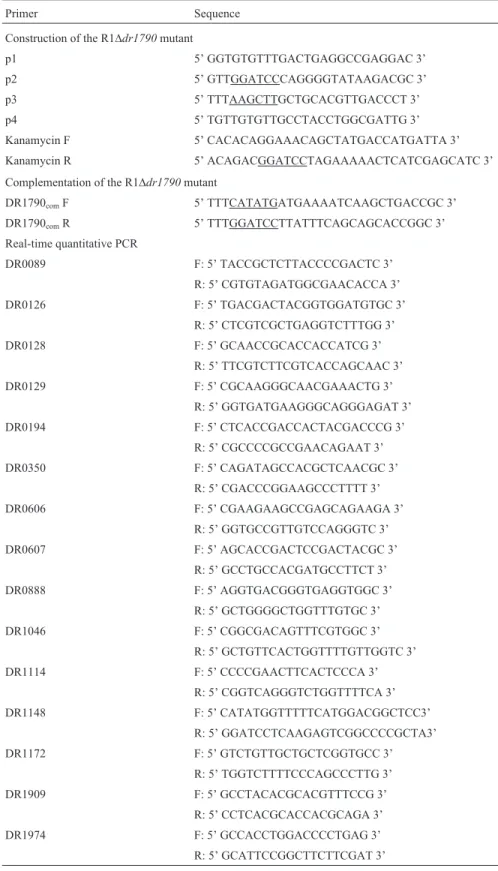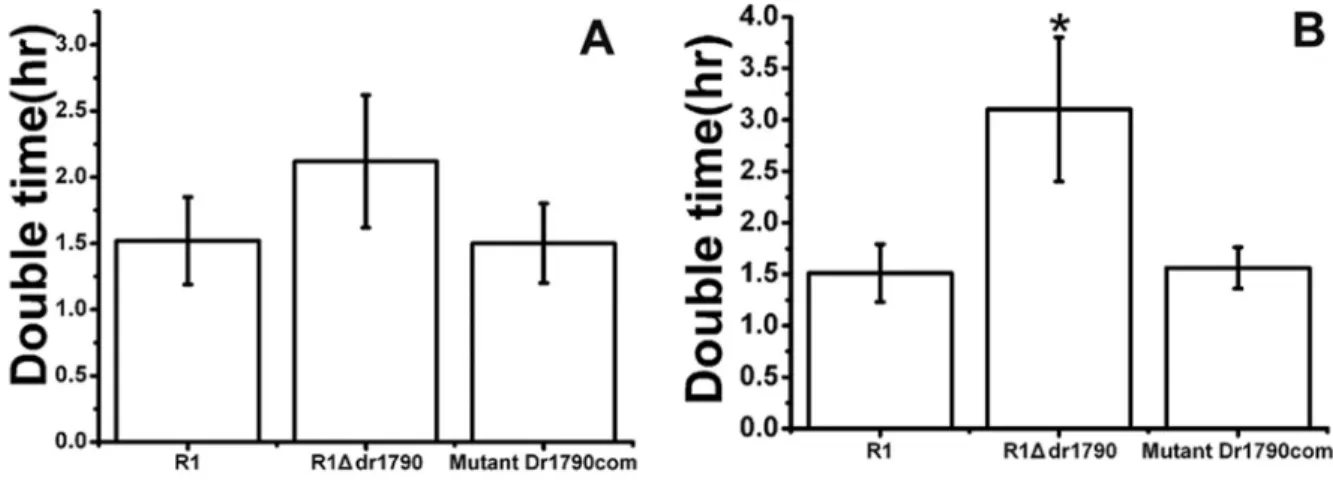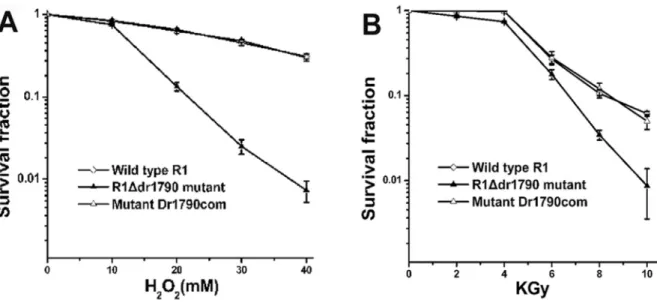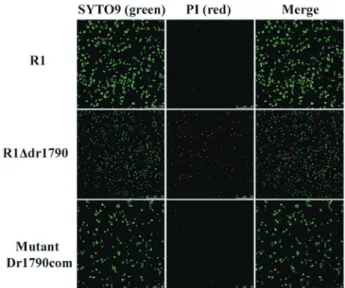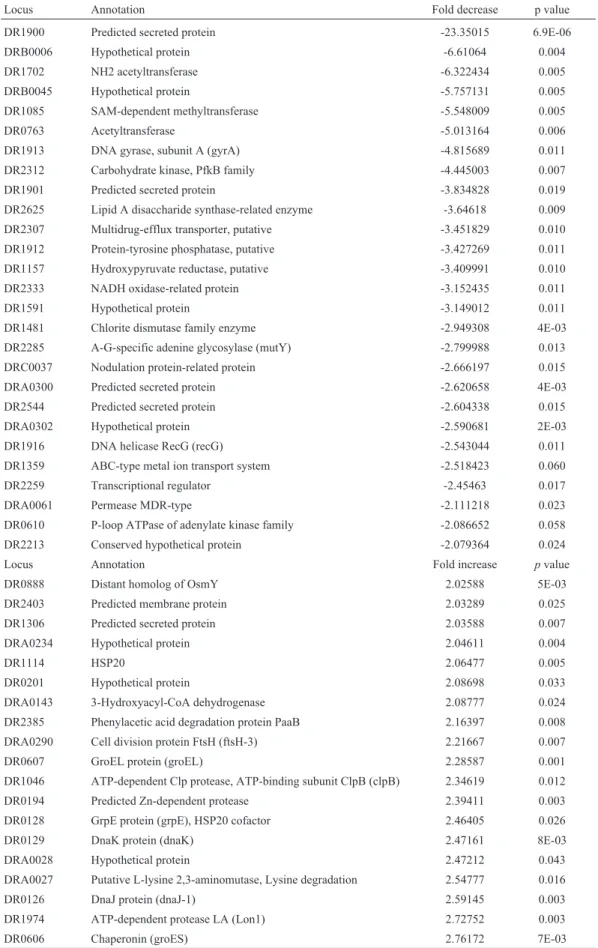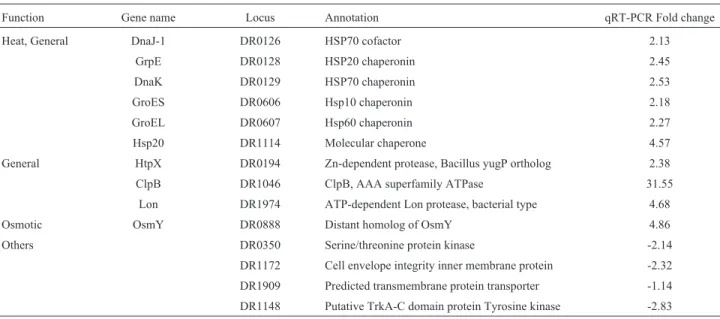Characteristics of
dr1790
disruptant and its functional analysis
in
Deinococcus radiodurans
Jianhui Cheng
1, Hu Wang
3, Xin Xu
2, Liangyan Wang
2, Bing Tian
2, Yuejin Hua
21
Institute of Horticulture, Zhejiang Academy of Agricultural Sciences, Hangzhou, China. 2
Institute of Nuclear-Agricultural Sciences, Zhejiang University, Hangzhou, China. 3
Institute of Ageing Research, Hangzhou Normal University, Hangzhou, China.
Submitted: May 3, 2013; Approved: December 19, 2014.
Abstract
Deinococcus radiodurans(DR) is an extremophile that is well known for its resistance to radiation, oxidants and desiccation. The gene dr1790 of D. radiodurans was predicted to encode a yel-low-related protein. The primary objective of the present study was to characterize the biological function of the DR1790 protein, which is a member of the ancient yellow/major royal jelly (MRJ) protein family, in prokaryotes. Fluorescence labeling demonstrated that the yellow-related protein encoded bydr1790is a membrane protein. The deletion of thedr1790gene decreased the cell growth rate and sensitivity to hydrogen peroxide and radiation and increased the membrane permeability of
D.radiodurans. Transcript profiling by microarray and RT-PCR analyses of thedr1790deletion mu-tant suggested that some genes that are involved in protein secretion and transport were strongly sup-pressed, while other genes that are involved in protein quality control, such as chaperones and proteases, were induced. In addition, the expression of genes with predicted functions that are in-volved in antioxidant systems, electron transport, and energy metabolism was significantly altered through the disruption ofdr1790. Moreover, the results of proteomic analyses using 2-DE and MS also demonstrated that DR1790 contributed toD.radioduranssurvival. Taken together, these results indicate that the DR1790 protein from the ancient yellow protein family plays a pleiotropic role in the survival of prokaryotic cells and contributes to the extraordinary resistance ofD. radioduransagainst oxidative and radiation stresses.
Key words:Deinococcus radiodurans,dr1790disruptant, characteristics, functional analysis.
Introduction
D.radiodurans exhibits resistance to the lethal and mutagenic effects of DNA damaging agents, including g-ray and UV radiation, hydrogen peroxide and desiccation (Battista, 1997; Makarovaet al., 2001; Shu and Tian, 2010; Ghosalet al., 2005). These bacteria can survive ~12 kGy g-ray irradiation, which generates approximately 200 dou-ble-strand and 3000 single-strand breaks per genome (Bat-tista, 2000). The robustness of this bacterium reflects strong oxidative stress resistance mechanisms that protect proteins from oxidative damage (Wanget al., 1995; Mar-killieet al., 1999; Dalyet al., 2007) and a DNA repair pro-cess that efficiently and precisely reassembles DNA fragments (Minton 1994; Sladeet al., 2009). Antioxidant
protection and repair mechanisms for DNA and other pro-teins enable these molecules to retain their catalytic activity and to provide a swift response under oxidative stress con-ditions (Slade and Radman, 2011). Genetic engineering techniques may be applied toD. radiodurans, which has extreme resistance, as well as the ability to self-repair DNA damage, to bioremediate radioactive waste sites, to breed plants for resistance and to treat human cancer. Therefore,
D. radiodurans, which is of interest to many researchers, represents a microbial resource with great development prospects.D. radioduransstrains that express the cloned Hg(II) resistance gene (merA) from theE. colistrain BL308 exhibit growth in the presence of both 60 Gy/h of137Cs ra-diation (a dose rate that exceeds those in most radioactive
Send correspondence to Y. Hua. Institute of Nuclear-Agricultural Sciences, Zhejiang University, 310029 Hangzhou, China. E-mail: yjhua@zju.edu.cn.
waste sites) and 30-50mM Hg(II) and that effectively re-duce Hg(II) to the less toxic volatile elemental Hg(0) (Brim
et al., 2000). The cloning of toluene dioxygenasetodgenes fromPseudomonas putida F1 into the chromosome ofD. radioduransconferred the ability to oxidize toluene, chlo-robenzene, 3,4-dichloro-1-butene, and indole in a highly ir-radiating environment (Langeet al., 1998). The expression ofIrrE, which is a global regulator for extreme radiation re-sistance inD. radiodurans, significantly enhanced salt tol-erance in Brassica napus plants. Transgenic B. napus
plants that express theIrrE can tolerate 350 mM NaCl, which is a concentration that inhibits the growth of almost all crop plants (Panet al., 2009). The human bone marrow cell line KG1a, which was transformed withdr1709from
D. radiodurans, exhibited a much higher survival fraction than the original KG1a cells when treated withg-ray radia-tion (Shu and Tian, 2012). However, the underlying mecha-nisms of D. radiodurans resistance to stresses remain unclear. Therefore, the identification and functional analy-sis of new genes that are associated with anti-radiation, DNA repair and antioxidants will improve our understand-ing of the extreme radiation resistance mechanisms of this strain and provide strategies for research regarding the radi-ation damage defense and oxidative stress resistance sys-tems of organisms.
dr1790, which is a gene that encodes a putative yel-low-related protein homolog, was identified in the D. radiodurans genome (Makarova et al., 2001). Interest-ingly, this yellow-related protein is typically detected in in-sects and plays important roles in pigmentation and insect behaviors. The deletion of the yellow protein gene locus in
Drosophila not only affects larval pigmentation but also appears to affect insect behavior (Maleszka and Kucharski, 2000; Drapeau etal., 2006). Yellow protein can be secreted from cells because this protein contains a secretion signal peptide (Drapeau, 2003). Furthermore, other members of the Yellow/Major Royal Jelly (MRJ) protein family are ex-pressed in not only insects but also some bacterial and fungi species, suggesting that yellow proteins are evolutionarily ancient (Drapeauet al., 2006). Although a few studies have demonstrated an association between melanization and be-havior inDrosophila, and a unique clade of genes from
Apis melliferamay be involved in caste specification, the function of most yellow protein family members remains largely unknown (Ferguson et al., 2011). Currently, no studies concerning the function of yellow-related proteins in prokaryotes exist. DR1790 expression was induced in a
D. radioduransmutant strain that was deficient in OxyR, which is a peroxide sensor and transcription regulator that senses the presence of reactive oxygen species and that in-duces the antioxidant system ofD.radiodurans(Chenet al., 2008). These findings prompted us to investigate the functions of this yellow-related protein homolog in this extremophilic bacterium.
Materials and Methods
Bacterial strains and materials
AllD. radioduranscultures were grown at 30 °C in tryptone-yeast extract-glucose (TGY) media (0.5% bacto-tryptone, 0.3% bacto-yeast extract, and 0.1% glucose) with aeration or on TGY plates solidified with 1.5% agar. Over-night cultures were incubated in fresh TGY medium, and exponential-phase cells (OD600nm= 0.8) were used for all experiments. TheE. colistrain JM109 was grown in Luria-Bertani (LB) broth (1.0% bacto-tryptone, 0.5% bacto-yeast extract, and 1.0% NaCl) or on LB plates solidified with 1.5% agar at 37 °C.
Construction of mutant strains
The D. radiodurans strain R1Ddr1790 was con-structed using a deletion replacement method as described previously (Xuet al., 2008). The primers that were used in this study are listed in Table 1. The primers p1 and p2 were used to amplify aBamHI fragment upstream of the targeted genes, and the primers p3 and p4 were used to amplify a
HindIII fragment downstream of the targeted genes. The kanamycin resistance cassette containing theGroEL pro-moter was obtained from the pRADK shuttle plasmid (Gao
et al., 2005). The three DNA fragments were digested and ligated; then, the ligation products were used as templates for PCR (30 cycles at 94 °C for 1 min, 55 °C for 45 s, and 72 °C for 1 min) with p1 and p4. The resulting PCR fragments were transformed intoD. radioduranscells using the CaCl2 technique, and the mutant strains were selected on TGY agar plates supplemented with 20mg/mL kanamycin.
Complementation of R1Ddr1790
The complementation plasmid was constructed as de-scribed previously (Gao et al., 2005; Wu et al., 2009). Briefly, chromosomal DNA was isolated from wild type strains. The 1167-bp region containing the dr1790 gene was PCR-amplified (35 cycles at 94 °C for 1 min, 58 °C for 50 s and 72 °C for 1 min) using the primers DR1790comF and DR1790comR (Table 1) and ligated into the pMD18 T-Easy vector (Takara, JP); the resulting construct was des-ignated as pMD-dr1790. After digestion with NdeI and
BamHI, the target genedr1790was ligated intoNdeI- and
BamHI-pre-digested pRADK, and the resulting construct was designated as pRAD-dr1790. The complementation plasmids were confirmed by PCR and DNA sequence anal-yses; thus, transformation into R1Ddr1790 generated the functional complementation strain mutant Dr1790com.
Measurement of growth rate
(200 rpm). Then, the culture dilutions were spread onto TGY agar plates after 2 (t1) and 4 h (t2). The plates were in-cubated at 30 °C for 5 days, and subsequently, the number of colony-forming units (CFU) was determined. The
dou-ble time (g) was calculated according to the following for-mula:g= ln2 / ((log10N2- log10N1) 2.303/Dt), where N1is CFU per milliliter at t1, and N2is CFU per milliliter at t2.
Table 1- Primers used in this study.
Primer Sequence
Construction of the R1Ddr1790mutant
p1 5’ GGTGTGTTTGACTGAGGCCGAGGAC 3’
p2 5’ GTTGGATCCCAGGGGTATAAGACGC 3’
p3 5’ TTTAAGCTTGCTGCACGTTGACCCT 3’
p4 5’ TGTTGTGTTGCCTACCTGGCGATTG 3’
Kanamycin F 5’ CACACAGGAAACAGCTATGACCATGATTA 3’
Kanamycin R 5’ ACAGACGGATCCTAGAAAAACTCATCGAGCATC 3’
Complementation of the R1Ddr1790mutant
DR1790comF 5’ TTTCATATGATGAAAATCAAGCTGACCGC 3’
DR1790comR 5’ TTTGGATCCTTATTTCAGCAGCACCGGC 3’
Real-time quantitative PCR
DR0089 F: 5’ TACCGCTCTTACCCCGACTC 3’
R: 5’ CGTGTAGATGGCGAACACCA 3’
DR0126 F: 5’ TGACGACTACGGTGGATGTGC 3’
R: 5’ CTCGTCGCTGAGGTCTTTGG 3’
DR0128 F: 5’ GCAACCGCACCACCATCG 3’
R: 5’ TTCGTCTTCGTCACCAGCAAC 3’
DR0129 F: 5’ CGCAAGGGCAACGAAACTG 3’
R: 5’ GGTGATGAAGGGCAGGGAGAT 3’
DR0194 F: 5’ CTCACCGACCACTACGACCCG 3’
R: 5’ CGCCCCGCCGAACAGAAT 3’
DR0350 F: 5’ CAGATAGCCACGCTCAACGC 3’
R: 5’ CGACCCGGAAGCCCTTTT 3’
DR0606 F: 5’ CGAAGAAGCCGAGCAGAAGA 3’
R: 5’ GGTGCCGTTGTCCAGGGTC 3’
DR0607 F: 5’ AGCACCGACTCCGACTACGC 3’
R: 5’ GCCTGCCACGATGCCTTCT 3’
DR0888 F: 5’ AGGTGACGGGTGAGGTGGC 3’
R: 5’ GCTGGGGCTGGTTTGTGC 3’
DR1046 F: 5’ CGGCGACAGTTTCGTGGC 3’
R: 5’ GCTGTTCACTGGTTTTGTTGGTC 3’
DR1114 F: 5’ CCCCGAACTTCACTCCCA 3’
R: 5’ CGGTCAGGGTCTGGTTTTCA 3’
DR1148 F: 5’ CATATGGTTTTTCATGGACGGCTCC3’
R: 5’ GGATCCTCAAGAGTCGGCCCCGCTA3’
DR1172 F: 5’ GTCTGTTGCTGCTCGGTGCC 3’
R: 5’ TGGTCTTTTCCCAGCCCTTG 3’
DR1909 F: 5’ GCCTACACGCACGTTTCCG 3’
R: 5’ CCTCACGCACCACGCAGA 3’
DR1974 F: 5’ GCCACCTGGACCCCTGAG 3’
Cell survival under oxidative stress and ionizing radiation
The hydrogen peroxide sensitivity ofD. radiodurans
cells was assayed as described previously (Wang et al., 2008), with some modifications. The cells were harvested during the early stationary phase (OD600nm= 1.0), washed twice and re-suspended with phosphate buffer (20 mM, pH 7.4). An aliquot was removed as a control, and the remain-ing suspension was treated with hydrogen peroxide at a fi-nal concentration of 20 mM. The mixture was incubated at 30 °C in an orbital shaker. Catalase (Sigma-Aldrich) was added in excess (15 U) to terminate the H2O2treatment. Then, the cells were diluted and spread onto solid TGY me-dia to determine the number of CFUs. The survival frac-tions were defined as a percentage of the CFU obtained in the treated sample compared with the control. The data are presented as the means±SD of three independent experi-ments.
The cell survival fractions under ionizing radiation were determined using a previously described method (Wanget al., 2008).
Measurement of protein carbonylation levels
Protein carbonylation, which is an indicator of intra-cellular protein oxidation, was measured using the DNPH (2,4-dinitrophenyl hydrazine) method (Tianet al., 2009).
Membrane localization of the DR1790 protein
The plasmid pRADG-dr1790was constructed as de-scribed previously (Gaoet al., 2008). pRADG-dr1790was transformed into the R1Ddr1790mutant strain. The trans-formant was obtained by chloramphenicol-resistance selec-tion. The transformant was grown to the exponential phase (OD600nmis approximately 0.8), spread on a glass slide and examined using a laser confocal microscope (Zeiss LSM510, Germany).
Membrane integrity assessment
Differences in membrane permeability between the varying strains were assessed using a LIVE/DEAD BacLight Bacterial Viability Kit (Invitrogen, Carlsbad, CA, USA). This system employs two nucleic acid stains: green-fluorescent SYTO9 stain and red-fluorescent pro-pidium iodide (PI) stain. Live cells with intact membranes fluoresced green, while dead cells or cells with compro-mised membranes fluoresced red. Bacterial cells were grown to mid-exponential phase, and a 1-mL aliquot of the culture was normalized to an OD600nmequal to 0.6, washed twice with PBS, and resuspended in 1 mL PBS. The bacte-rial suspensions were stained with the nucleic acid dyes ac-cording to the manufacturer’s protocol; then, 10mL stained bacteria was spotted onto glass coverslips and visualized using a Leica DM4000B wide-field epifluorescence micro-scope (Leica Microsystems, Wetzlar, Germany). In total,
10 different fields were viewed for each strain, and the numbers of green, red or mixed cells were counted for each field.
Transcriptome analysis
The procedures used for microarray hybridization and data analyses were performed as described previously (Chenet al., 2008). Briefly, total RNA was prepared from three replicates of wild type and R1Ddr1790mutant cells. Approximately 16mg total RNA was annealed with 10mg random hexamer primers in a total volume of 20 mL at 70 °C for 10 min, followed by incubation on ice for 2 min. cDNA synthesis was performed at 42 °C overnight in a 31-mL reaction mixture using SuperScript III Reverse Transcriptase (Invitrogen) with 0.5 mM dNTP mix contain-ing amino allyl-dUTP (GE, Piscataway, NJ, USA). The re-action was terminated by adding 20mL 0.5 M EDTA and 20mL 1 M NaOH, followed by heating at 65 °C for 20 min. The reaction mixture was neutralized with 50 mL 1 M HEPES buffer (pH 7.0), and unincorporated amino allyl-dUTPs were removed by ultra-filtration using YM 30 columns (Millipore). The cDNA was coupled to 1 pmol Cy3 or Cy5 dye (GE) in 0.1 M sodium carbonate buffer for 2 h at room temperature, and free Cy3 or Cy5 was removed. The labeled pools of wild type and R1Ddr1790 mutant cDNA were mixed and simultaneously hybridized with the DNA chips in a solution containing 3X saline sodium ci-trate (SSC), 0.3% SDS, and 24mg unlabeled herring sperm DNA (Gibco BRL, Gaithersburg, MD, USA). Normaliza-tion and statistical analysis were performed in the R com-puting environment (version 2.2.0, R with Aqua for Windows) using the linear modeling features of the Limma microarray data package (Wettenhallet al., 2004). Before channel normalization, microarray outputs were filtered us-ing Limma to remove spots with poor signal quality by ex-cluding data points with a mean intensity less than two standard deviations above the background in both channels. Then, global LOESS normalization was used to normalize all data, and three replicate spots per gene in each array were used to maximize the robustness of the differential ex-pression measurement of each gene via the “lmFit” func-tion. The transcriptome analysis data were deposited in the Gene Expression Omnibus database under accession no. GSE22628.
Real-time quantitative PCR
using a Toyobo SYBR Green I Real Time PCR kit (Japan) according to the manufacturer’s instructions under the fol-lowing conditions: 94 °C for 2 min, followed by 40 cycles at 94 °C for 10 s, annealing at 56-62 °C for 15 s and 72 °C for 30 s. All assays were performed using a Stratagene Mx3005P qPCR system (Stratagene, Cedar Creek, TX, USA).
Proteomics analysis
Proteomic analysis of the mutant compared with the wild type strain was performed using 2-DE and data analy-ses, in-gel digestion, MALDI-TOF MS analysis and a PMF spectra-based database search (Luet al., 2009).
Results
Growth of the deletion mutant
We assayed the doubling time of cells in the lag and log phases. The R1Ddr1790 mutant doubling time (2.1±0.4 h) was not significantly slower than the doubling time (1.5±0.4 h) of the wild type R1 strain under aerobic conditions during the lag phase (p > 0.05) (Figure 1A). However, the R1Ddr1790 mutant doubling time (3.1± 0.5 h) was slightly slower than the doubling time (1.6±0.2 h) of the wild type R1 strain under aerobic condi-tions during the log phase (p< 0.05) (Figure 1B).
The deletion mutant was sensitive to oxidative stress and radiation
The yellow-related protein homolog DR1790 fromD. radiodurans functions has been implicated in cell resis-tance to oxidative stress and radiation. The R1Ddr1790 mu-tant was sensitive to hydrogen peroxide treatment andg-ray radiation. Compared with the wild type strains, the survival of the R1Ddr1790mutant cells decreased nearly 15-fold in
response to 30 mM hydrogen peroxide (Figure 2A) and nearly 3-fold in response to a 8 kGy dose (Figure 2B).
To determine whether the loss of DNA damage toler-ance in the R1Ddr1790 mutant reflected the absence of
dr1790and not a polar effect of this mutation, the wild type allele of this gene was cloned into pRADgro, which is a
Deinococcus expression vector, and the protein was ex-pressed in R1Ddr1790mutant cells. The radiation and oxi-dative resistance of the complemented mutant Dr1790com strain nearly recovered to the phenotype of the wild type strain (Figure 2), suggesting that the sensitivity of the R1Ddr1790 mutant reflected the absence of the dr1790
gene.
Comparison of intracellular protein oxidation levels between the wild type R1 strain and the R1Ddr1790
mutant strain
The level of protein oxidation in the R1Ddr1790 mu-tant was analyzed and compared with that of the wild type R1 strain (Figure 3). The total protein carbonyl contents measured in the wild type and mutant strains were 0.012 and 0.015 mmol/mg, respectively, indicating that the mu-tant strain exhibited relatively higher levels of protein oxi-dation compared with the wild type strain in the absence of oxygen stress. Following H2O2treatment, intracellular pro-tein carbonylation significantly increased in both the wild type and R1Ddr1790mutant strains. The carbonyl content in the R1Ddr1790 mutant post-H2O2 treatment was 0.023 mmol/mg protein, which was significantly higher than the content in the wild type cells (0.017 mmol/mg pro-tein,p< 0.05), suggesting that the intracellular proteins in the mutant cells lacking DR1790 were more sensitive to ox-idative damage than those in the wild type cells.
Membrane localization of the DR1790 protein and membrane integrity of the R1Ddr1790mutant strain
Fusion gene expression of the green fluorescence pro-tein (eGFP) gene anddr1790was performed and analyzed by fluorescence microscopy to confirm the localization of the DR1790 protein (Gaoet al., 2008). Figure 4 shows that eGFP-labeled protein (green fluorescence) was localized to the cell membrane; the yellow fluorescence displayed in the merged picture indicates the co-localization of eGFP-labeled proteins and FM4-64 (red fluorescence)-eGFP-labeled
membranes, confirming that DR1790 is a membrane protein.
The membrane integrity of the mutant strain was ana-lyzed based on permeability assays using membrane-per-meant and membrane-impermembrane-per-meant fluorescence-labeled nucleic acids. The R1Ddr1790 mutant incorporated both the membrane-impermeant dye propidium iodide (PI) and the membrane-permeant dye SYTO9 (Figure 5). Of 1384 mutant bacterial cells counted in 10 different fields, 20% of the cells incorporated PI (red). In contrast, wild type R1 and complemented mutant Dr1790com strains incorporated SYTO9 (green); however, only 1% of the cells were PI-positive among the 1464 wild type and 1538 complemented mutant bacteria that were counted in 10 independent fields (Figure 5). Thus, the R1Ddr1790 mutant showed a high proportion of damaged membranes (20% red cells observed in the mutant field) compared with wild type and
comple-Figure 2- Survival curves forD. radioduransfollowing exposure to H2O2(A) and gamma radiation (B). Each data point represents the mean of three
rep-licates (bars indicate the standard deviations).
Figure 3- Comparison of the intracellular protein carbonylation levels be-tween wild type R1 and R1Ddr1790mutant strains following H2O2
treat-ment. R1 and M represent wild type R1 and R1Ddr1790mutant strains un-der normal conditions, respectively. R1+ and M+ represent wild type R1 and R1Ddr1790mutant strains following H2O2treatment, respectively.
Each data point represents the mean of three replicates (bars indicate the standard deviations). The results were assessed using Student’st-test, and statistical significance was considered at p < 0.05.
mented mutant strains. This result suggests that the DR1790 protein contributes to membrane permeability.
Transcriptional and translational profiles of the DR1790 mutantvs.the wild type strain
2-DE and MS analyses were applied to compare the differential protein expression profiles of the R1Ddr1790
mutant and the wild type R1 strains (Figure 6). Ten protein spots showing two-fold changes in intensity in the R1Ddr1790mutant compared with the wild type R1 were observed, including growth-related metabolism enzymes (IDH, MDH and FBP2), the predicted transmembrane pro-tein transporter DR1909, and the chaperone propro-tein DnaJ (Table 2). The limited information acquired by 2-DE analy-sis prompted the use of DNA microarray analyanaly-sis to inves-tigate this issue further.
The transcriptome of the R1Ddr1790 mutant was ana-lyzed and compared with that of the wild type strain under normal growth conditions using oligonucleotide micro-array to examine the expression of the entire gene reper-toire ofD. radioduransin response todr1790knockout. In the present study, a two-fold difference in the relative tran-scription level was selected as the threshold for microarray data analysis as described previously by Chenet al.(2008). We observed that 1.5% of the genes represented on the microarray (n = 46) were differentially transcribed in the R1Ddr1790mutant compared with the WT. Among these genes, 27 were up-regulated (Table 3), and 19 were down-regulated (Table 3). These genes were involved in DNA/RNA repair, energy metabolism, various transport-ers, proteases and chaperones, stress responses, and transla-tion and transcriptransla-tion functransla-tions.
Among the up-regulated genes in the R1Ddr1790 mu-tant, three genes were categorized as proteinase genes, six genes were related to protein quality control, and some genes encoded unknown/hypothetical proteins. Similarly, the down-regulated genes in the R1Ddr1790 mutant in-cluded four genes that were related to secreted proteins. The effectiveness of the microarray data was further con-firmed by real-time quantitative RT-PCR (Table 4).
Nota-Table 2- Mass spectrometry identification of the protein spots that were separated by 2-DE analysis.
Protein spot Locus Length (aa) Functional category Expression ratio, mutant 1790/WT (fold)
1 DR1540 430 Isocitrate dehydrogenase (IDH) 0.05
2 DR2013 268 Fructose 1,6-bisphosphatase II (FBP2) 0.09
3 DR0325 330 Malate dehydrogenase (MDH) 0.03
4 DR1512 264 Elongation factor Ts 0.09
5 DR0350 571 Serine/threonine protein kinase 0.29
6 DRA0337 386 Glutaryl-CoA dehydrogenase 2.49
7 DR1172 298 Cell envelope integrity inner membrane protein 0.18
8 DR1909 212 Predicted transmembrane protein transporter 0.09
9 DR1148 175 Putative TrkA-C domain protein Tyrosine kinase 2.56
10 DR0126 312 Chaperone protein DnaJ 3.39
Figure 5- Stained images of wild type R1, R1Ddr1790and complemented Mutant Dr1790com strains using a LIVE/DEAD kit (100). Live cells with intact membranes only incorporated SYTO9 (green), whereas dead cells or cells with compromised membranes incorporated PI (red).
Table 3- Summary of the gene expression results from microarray data. The 27 most highly repressed genes in the R1Ddr1790mutant. The 19 most highly induced genes in the R1Ddr1790mutant.
Locus Annotation Fold decrease p value
DR1900 Predicted secreted protein -23.35015 6.9E-06
DRB0006 Hypothetical protein -6.61064 0.004
DR1702 NH2 acetyltransferase -6.322434 0.005
DRB0045 Hypothetical protein -5.757131 0.005
DR1085 SAM-dependent methyltransferase -5.548009 0.005
DR0763 Acetyltransferase -5.013164 0.006
DR1913 DNA gyrase, subunit A (gyrA) -4.815689 0.011
DR2312 Carbohydrate kinase, PfkB family -4.445003 0.007
DR1901 Predicted secreted protein -3.834828 0.019
DR2625 Lipid A disaccharide synthase-related enzyme -3.64618 0.009
DR2307 Multidrug-efflux transporter, putative -3.451829 0.010
DR1912 Protein-tyrosine phosphatase, putative -3.427269 0.011
DR1157 Hydroxypyruvate reductase, putative -3.409991 0.010
DR2333 NADH oxidase-related protein -3.152435 0.011
DR1591 Hypothetical protein -3.149012 0.011
DR1481 Chlorite dismutase family enzyme -2.949308 4E-03
DR2285 A-G-specific adenine glycosylase (mutY) -2.799988 0.013
DRC0037 Nodulation protein-related protein -2.666197 0.015
DRA0300 Predicted secreted protein -2.620658 4E-03
DR2544 Predicted secreted protein -2.604338 0.015
DRA0302 Hypothetical protein -2.590681 2E-03
DR1916 DNA helicase RecG (recG) -2.543044 0.011
DR1359 ABC-type metal ion transport system -2.518423 0.060
DR2259 Transcriptional regulator -2.45463 0.017
DRA0061 Permease MDR-type -2.111218 0.023
DR0610 P-loop ATPase of adenylate kinase family -2.086652 0.058
DR2213 Conserved hypothetical protein -2.079364 0.024
Locus Annotation Fold increase pvalue
DR0888 Distant homolog of OsmY 2.02588 5E-03
DR2403 Predicted membrane protein 2.03289 0.025
DR1306 Predicted secreted protein 2.03588 0.007
DRA0234 Hypothetical protein 2.04611 0.004
DR1114 HSP20 2.06477 0.005
DR0201 Hypothetical protein 2.08698 0.033
DRA0143 3-Hydroxyacyl-CoA dehydrogenase 2.08777 0.024
DR2385 Phenylacetic acid degradation protein PaaB 2.16397 0.008
DRA0290 Cell division protein FtsH (ftsH-3) 2.21667 0.007
DR0607 GroEL protein (groEL) 2.28587 0.001
DR1046 ATP-dependent Clp protease, ATP-binding subunit ClpB (clpB) 2.34619 0.012
DR0194 Predicted Zn-dependent protease 2.39411 0.003
DR0128 GrpE protein (grpE), HSP20 cofactor 2.46405 0.026
DR0129 DnaK protein (dnaK) 2.47161 8E-03
DRA0028 Hypothetical protein 2.47212 0.043
DRA0027 Putative L-lysine 2,3-aminomutase, Lysine degradation 2.54777 0.016
DR0126 DnaJ protein (dnaJ-1) 2.59145 0.003
DR1974 ATP-dependent protease LA (Lon1) 2.72752 0.003
bly, many molecular chaperones and proteinases were positively regulated in the R1Ddr1790mutant, and trans-porters and kinases were negatively regulated in the R1Ddr1790mutant. These data demonstrate that the dele-tion of thedr1790gene significantly increased the amount of misfolded proteins in the cell.Some secreted proteins and transmembrane protein transporters were repressed, in-dicating that the DR1790 protein could be associated with secretory factors in the membrane.
Discussion
The extreme resilience ofD. radioduransto oxidative and radiation stresses is imparted synergistically by the ef-ficient protection of proteins against oxidative stress and efficient DNA repair mechanisms, enhanced by functional redundancies in both systems (Slade and Radman, 2011). Maleszka et al. (2000) identified an orphan protein (DR1790) in D. radiodurans belonging to the yellow-related protein family, which was originally identified in
Drosophila. A mutation in the yellow-related protein in
Drosophilaaffects the pigmentation of larvae and exerts some effects on insect behavior (Drapeauet al., 2006). In the present study, the predicted yellow-related protein DR1790, which belongs to the ancient Yellow/MRJ protein family, was confirmed to be a membrane-binding protein. A null-mutant strain (R1Ddr1790) exhibited reduced sur-vival after gamma irradiation and H2O2treatment, demon-strating that DR1790 is involved in the radioresistance and antioxidant mechanisms ofD. radiodurans. Protein, rather than DNA, was suggested to be the principal target of radia-tion and free radicals, and the degree of cell resistance was determined based on the level of oxidative protein damage (Dalyet al., 2007). We observed that the total protein
car-bonyl contents increased in the R1Ddr1790 mutant under normal conditions and H2O2treatment, demonstrating that the absence of DR1790 increased oxidative damage in cells.
Cellular membranes, which are composed of lipids, proteins, and carbohydrates, are damaged by radiation. The melting of membranes under stress results in permeability barrier loss and leakage, as well as the inability to maintain a proton gradient for respiration. TheD. radioduranscell envelope consists of at least five layers (Lancyet al., 1978).
D. radioduransirradiated with 4 kGy loses up to 30% wet weight resulting from the loss of polysaccharides into the growth medium, which suggests permeability alterations in the cell envelope (Mitchel, 1976). For retaining membrane integrity,D. radioduranscells were much more resistant to high temperatures when exposed in the dried state as op-posed to cells in suspension (Bauermeisteret al., 2012). The R1Ddr1790mutant showed a high proportion of dam-aged membranes (20% red cells observed in the mutant field) compared with wild type and complemented mutant strains. This result suggests that the DR1790 protein con-tributes to membrane permeability. Consequently, the mu-tant strain was more sensitive to both ionizing radiation and oxidative stress. However, how DR1790 contributes to bacterial membrane integrity remains unclear. DR1790 may be required for the stability of membrane protein com-plexes to restore the osmotic imbalance rapidly, and the ab-sence of DR1790 may result in less stability or improperly gated channels or pores. Thus, the isolation of the protein partners of DR1790 may help to clarify the role of this pro-tein in membrane homeostasis. Alterations in membrane integrity may also contribute to the increased sensitivity of R1Ddr1790mutants to oxidative and radiation stresses.
Table 4- Real-time PCR relative quantification of the expression of repressed and induced genes in the R1Ddr1790mutant compared with theD. radioduranswild type strain.
Function Gene name Locus Annotation qRT-PCR Fold change
Heat, General DnaJ-1 DR0126 HSP70 cofactor 2.13
GrpE DR0128 HSP20 chaperonin 2.45
DnaK DR0129 HSP70 chaperonin 2.53
GroES DR0606 Hsp10 chaperonin 2.18
GroEL DR0607 Hsp60 chaperonin 2.27
Hsp20 DR1114 Molecular chaperone 4.57
General HtpX DR0194 Zn-dependent protease, Bacillus yugP ortholog 2.38
ClpB DR1046 ClpB, AAA superfamily ATPase 31.55
Lon DR1974 ATP-dependent Lon protease, bacterial type 4.68
Osmotic OsmY DR0888 Distant homolog of OsmY 4.86
Others DR0350 Serine/threonine protein kinase -2.14
DR1172 Cell envelope integrity inner membrane protein -2.32
DR1909 Predicted transmembrane protein transporter -1.14
In the present study, some genes that are involved in protein quality control, such asdr1114(HSP20), dr0129
(dnaK), dr0126 (dnaJ), dr0607 (groEL), dr1046
(ATP-binding subunit ClpB), anddr1974(ATP-dependent protease LA, Lon1), were strongly induced in R1Ddr1790
mutants. The induction of these chaperones and proteases suggested that many damaged proteins aggregated in the R1Ddr1790mutant. Chaperones assist in non-covalent fol-ding or unfolfol-ding and in the assembly or disassembly of protein structures in the cell, but do not occur in these struc-tures during the performance of normal biological func-tions after having completed folding and/or assembly. DnaK/DnaJ/GrpE and GroEL/ES are the two primary chaperone foldase systems in prokaryotic cells (Hoffmann
et al., 2004). ATP-dependent proteases function in protein processing and play an essential role in diverse stress re-sponses (Gottesman, 2003). InD. radiodurans, the major-ity of cellular proteolysis is performed by ATP-dependent proteases that belong to the Lon (Lon1 and Lon2) and Clp families (ClpA, ClpB, ClpC, ClpX and ClpP). The ClpPX protease is required for radioresistance and regulates cell division afterg-irradiation inD. Radiodurans (Servantet al., 2007). ClpB fromMyxococcus xanthusfunctions as a chaperone protein and plays an important role in cellular heat and osmotic stress tolerance mechanisms during both vegetative growth and development (Pan et al., 2012). ClpB and the DnaK system act synergistically to remodel proteins and to dissolve aggregates (Doyleet al., 2007). HSPs function as molecular chaperones that prevent pro-tein denaturation and aggregation (Feder and Hofmann, 1999; Matuszewskaet al., 2008). Additionally, some genes that are involved in protein secretion and transport are strongly suppressed in R1Ddr1790mutants, such as secre-ted proteins (DR1900, DR1901, DRA0300, and DR2544) and transmembrane transporter proteins (DR1909), indi-cating that the DR1790 protein could be related to secretory factors in the membrane.D. radioduranscontains many se-creted proteases and transporters that provide exogenous amino acids as protein building blocks and peptides as components of manganese complexes (Slade and Radman, 2011). After irradiation in D. radiodurans, 10 secreted subtilisin-like proteases, and 4 peptide and amino acid ABC transporters were highly induced (Makarovaet al., 2000; Ghosalet al., 2005). Thus, the low growth rate and sensitivity to hydrogen peroxide and radiation in the R1Ddr1790mutant were closely associated with the induc-tion of these chaperones and proteases and with the sup-pression of secreted and transported proteins. Additionally, the expression of some genes involved in antioxidant sys-tems, electron transport, and energy metabolism were also significantly altered by the disruption of DR1790.
In conclusion, we presented the first experimental ev-idence that a protein from the ancient yellow protein family plays a role in the survival of prokaryote cells during a dam-age response. The DR1790 protein from the ancient yellow
protein family plays a pleiotropic role in the survival of prokaryotic cells and contributes to the extraordinary resis-tance of D. radiodurans against oxidative and radiation stresses. Further studies are required to understand the mechanisms of the action that are mediated by DR1790 during this process and to identify critical protein interac-tions.
Acknowledgments
This work was supported by grants from National Natural Science Foundation of China (31370102), the pro-ject for genetically modified organisms breeding from the Ministry of Agriculture of China (2014ZX08009-003), a grant from Special Fund for Agro-scientific Research in the Public Interest from the Ministry of Agriculture of China (201103007), the Natural Science Foundation of Zhejiang Province (LY13C010001), the Public Project of Zhejiang Province (2014C33024), the Fundamental Re-search Funds for the Central Universities from Zhejiang University (2012FZA6014), and the Project for Zhejiang Provincial Construction of Technology Innovation Team (2010R50033).
References
Battista JR (1997) Against all odds: the survival strategies of
Deinococcus radiodurans. Annu Rev Microbiol 51:203-224.
Battista JR (2000) Radiation resistance: the fragments that re-main. Curr Biol 10:204-205.
Bauermeister A, Hahn C, Rettberg Pet al.(2012) Roles of DNA repair and membrane integrity in heat resistance of
Deinococcus radiodurans. Arch Microbiol 194:959-966. Brim H, McFarlan SC, Fredrickson JKet al.(2000) Engineering
Deinococcus radioduransfor metal remediation in radioac-tive mixed waste environments. Nat Biotechnol 18:85-90. Chen H, Xu G, Zhao Yet al.(2008) A Novel OxyR Sensor and
Regulator of Hydrogen Peroxide Stress with One Cysteine Residue inDeinococcus radiodurans. PLoS One 3:e1602. Daly MJ, Gaidamakova EK, Matrosova VYet al.(2007) Protein
oxidation implicated as the primary determinant of bacterial radioresistance. PLoS Biol 5:e92.
Drapeau MD, Albert S, Kucharski Ret al.(2006) Evolution of the Yellow/Major Royal Jelly Protein family and the emergence of social behavior in honey bees. Genome Res 11:1385-1394.
Drapeau MD (2003) A novel hypothesis on the biochemical role of the DrosophilaYellow protein. Biochem Biophys Res Commun 311:1-3.
Doyle SM, Hoskins JR, Wickner S (2007) Collaboration between the ClpB AAA+ remodeling protein and the DnaK chape-rone system. Proc Natl Acad Sci USA 104:11138-11144. Feder ME, Hofmann GE (1999) Heat shock proteins, molecular
chaperones, and the stress response. Annu Rev Physiol 61:243-282.
Ferguson LC, Green J, Surridge Aet al.(2011) Evolution of the Insect Yellow Gene Family. Mol Biol Evol 28:257-272. Gao G, Lu H, Huang Let al.(2005) Construction of DNA damage
function-com-plementary mutants in Deinococcus radiodurans. Chinese Sci Bull 50:311-316.
Gao G, Fan L, Lu H et al. (2008) Engineering Deinococcus radiodurans into biosensor to monitor radioactivity and genotoxicity in environment. Chinese Sci Bull 53:1675-1681.
Ghosal D, Omelchenko MV, Gaidamakova EKet al.(2005) How radiation kills cells: survival ofDeinococcus radiodurans
and Shewanella oneidensis under oxidative stress. FEMS Microbiol Rev 29:361-375.
Gottesman S (2003) Proteolysis in bacterial regulatory circuits. Annu Rev Cell Dev Biol 19:565-587.
Hoffmann JH, Linke K, Graf PCFet al.(2004) Identification of a redox-regulated chaperone network. EMBO J 23:160-168. Lancy PJ, Murray RG (1978) The envelope of Micrococcus
radiodurans: isolation, purification, and preliminary analy-sis of the wall layers. Can J Microbiol 24:162-176. Lange CC, Wackett LP, Minton KWet al.(1998) Engineering a
recombinantDeinococcus radioduransfor organopollutant degradation in radioactive mixed waste environments. Nat Biotechnol 16:929-933.
Lu H, Gao G, Xu Get al.(2009)Deinococcus radioduransPprI switches on DNA damage response and cellular survival networks after radiation damage. Mol Cell Proteomics 8:481-494.
Makarova KS, Aravind L, Wolf YIet al.(2001) Genome of the extremely radiation-resistant bacterium Deinococcus radiodurans viewed from the perspective of comparative genomics. Microbiol Mol Biol Rev 65:44-79.
Makarova KS, Aravind L, Daly MJet al.(2000) Specific expan-sion of protein families in the radioresistant bacterium
Deinococcus radiodurans. Genetica 108:25-34.
Maleszka R, Kucharski R (2000) Analysis of Drosophila yel-low-B cDNA reveals a new family of proteins related to the royal jelly proteins in the honeybee and to an orphan protein in an unusual bacterium Deinococcus radiodurans. Bio-chem Biophys Res Commun 270:773-776.
Markillie LM, Varnum SM, Hradecky Pet al.(1999) Targeted mutagenesis by duplication insertion in the radioresistant bacteriumDeinococcus radiodurans: radiation sensitivities of catalase (katA) and superoxide dismutase (sodA) mutants. J Bacteriol 181:666-669.
Mattimore V, Udupa KS, Berne GAet al.(1995) Genetic charac-terization of forty ionizing radiation-sensitive strains of
Deinococcus radiodurans: linkage information from trans-formation. J Bacteriol 177:5232-5237.
Matuszewska E, Kwiatkowska J, Kuczynska-Wisnik D et al.
(2008)Escherichia coliheat-shock proteins IbpA/B are in-volved in resistance to oxidative stress induced by copper. Microbiol 154:1739-1747.
Minton KW (1994) DNA repair in the extremely radioresistant bacteriumDeinococcus radiodurans. Mol Microbiol 13:9-15.
Mitchel RE (1976) Ionizing radiation damage in Micrococcus radioduranscell wall: release of polysaccharide. Radiat Res 66:158-169.
Pan J, Wang J, Zhou Zet al.(2009) IrrE, a global regulator of ex-treme radiation resistance inDeinococcus radiodurans, en-hances salt tolerance in Escherichia coli and Brassica napus. PLoS One 2:e4422.
Pan H, Luan J, He Xet al.(2012) The clpB gene is involved in the stress response of Myxococcus xanthus during vegetative growth and development. Microbiol 158:2336-2343. Servant P, Jolivet E, Bentchikou Eet al.(2007) The ClpPX
prote-ase is required for radioresistance and regulates cell division after gamma-irradiation inDeinococcus radiodurans. Mol Microbiol 66:1231-1239.
Shu H, Tian B (2010) Radioresistance analysis ofDeinococcus radiodurans gene DR1709 in Escherichia coli. Afr J Microbiol Res13:1412-1418.
Shu H, Tian B (2012) The radioresistance analysis of the
Deinococcus radiodurans gene DR1709 in human bone marrow cell line KG1a. Afr J Microbiol Res 6:40-45. Slade D, Lindner AB, Paul Get al.(2009) Recombination and
replication in DNA repair of heavily irradiatedDeinococcus radiodurans. Cell 136:1044-1055.
Slade D, Radman M (2011) Oxidative Stress Resistance in
Deinococcus radiodurans. Mol Biol Rev 75:133-191 Tian B, Sun Z, Shen Set al.(2009) Effects of carotenoids from
Deinococcus radiodurans on protein oxidation. Lett Appl Microbiol 49:689-694.
Wang P, Schellhorn HE (1995) Induction of resistance to hydro-gen peroxide and radiation in Deinococcus radiodurans. Can J Microbiol 41:170-176.
Wang L, Xu G, Chen Het al.(2008) DrRRA: a novel response regulator essential for the extreme radioresistance of
Deinococcus radiodurans. Mol Microbiol 67:1211-1222. Wettenhall JM, Smyth GK (2004) limmaGUI: a graphical user
in-terface for linear modeling of microarray data. Bioinfor-matics 20:3705-3706.
Wu Y, Chen W, Zhao Yet al.(2009) Involvement of RecG in H2O2-induced damage repair inDeinococcus radiodurans.
Can J Microbiol 55:841-848.
Xu G, Wang L, Chen Het al.(2008) RecO is essential for DNA damage repair in Deinococcus radiodurans. J Bacteriol 190:2624-2628.
Associate Editor: Luis Henrique Souza Guimarães
